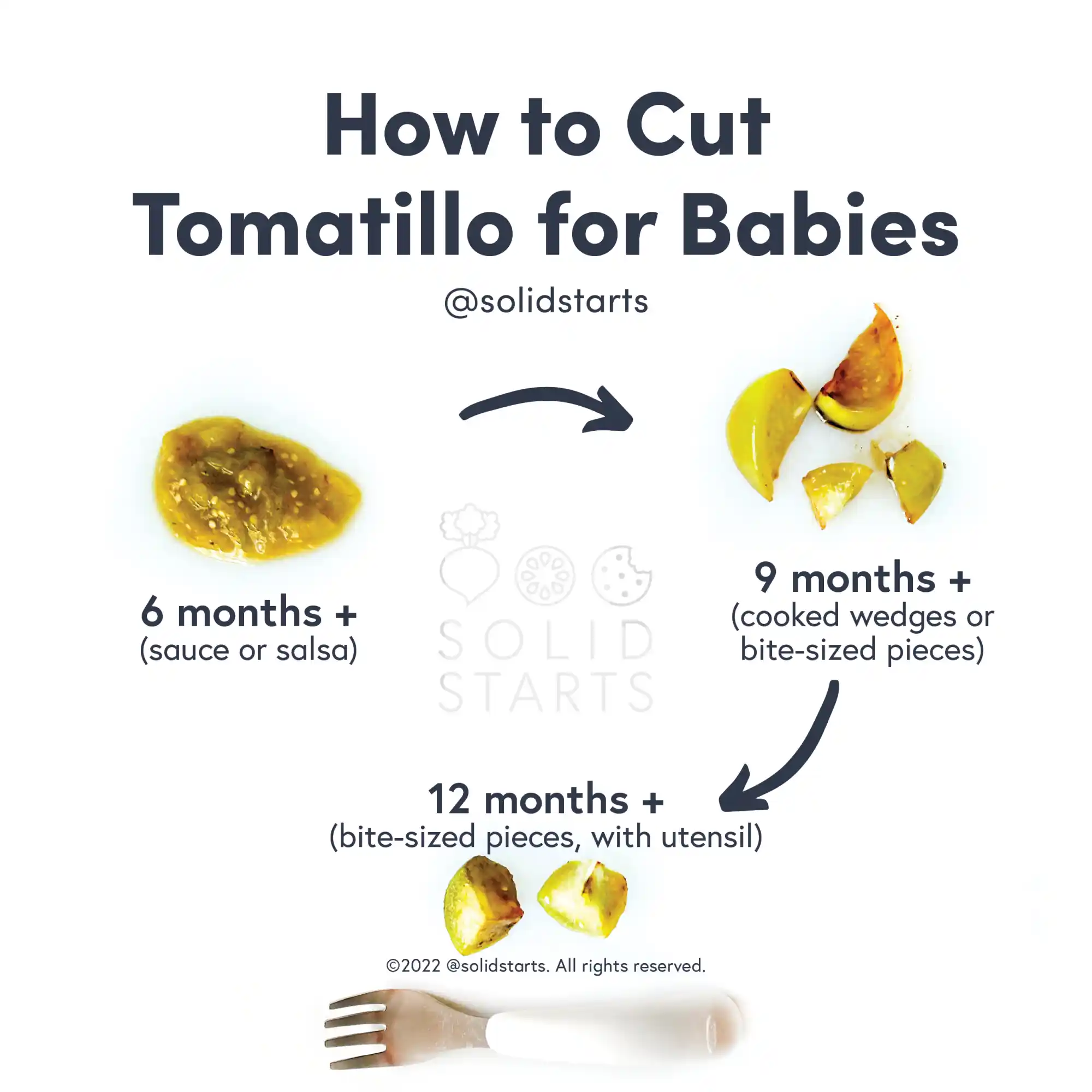Acceda a la base de datos First Foods® en Solid Starts App.
Leer másTomatillo
Vegetal
Sugerencia de edades
6 meses
Alto contenido de hierro
No
Alérgeno común
No

When can babies have tomatillo?
Tomatillo may be introduced as soon as baby is ready to start solids, which is generally around 6 months of age.
The tomatillo still grows wild in regions of Central and North America, where the plant originated, but it has also been cultivated for thousands of years. Along with maize and tomatoes, tomatillos were staples of the diet and economy for Aztec, Incan, and Mayan cultures. The tomatillo is a distant cousin to the tomato, but even more closely related to the goldenberry or uchuva, another fruit that grows inside a papery husk that must be removed before eating. Unlike the tomato, tomatillos remain green and firm, even when ripe, and they lend fresh, tart flavor to salsas, moles, tacos, and much more.
How do you serve tomatillo to babies?
Cada bebé se desarrolla a su propio ritmo, y las sugerencias que ofrecemos sobre cómo cortar o preparar determinados alimentos son generalizaciones para una amplia audiencia.
6 months old +:
Roughly chop and cook husked, washed tomatillos until soft. From there, you can stir the soft, cooked pieces into another soft, scoopable food. Alternatively, make a sauce or salsa from roasted tomatillos and drizzle onto baby’s food. If you have very large tomatillos (bigger than baby’s mouth), you can also offer soft, cooked halves or quarters of tomatillo for baby to munch on.
9 months old +:
Serve husked, cooked tomatillo that has been quartered, either on its own or as part of a meal. While you can offer cooked tomatillo in bite-sized pieces on their own, know that they may be slippery and difficult for baby to pick up. Roasted tomatillo quarters may be easier to pick up due to the ridges in the roasted skin. Or serve roasted tomatillos in a sauce or salsa over a variety of foods such as eggs, meats, or tacos.
12 months old +:
At this age, you can offer husked, cooked tomatillo in bite-sized pieces or wedges for the child to pick up with their pincer grasp or for utensil practice. Alternatively, continue to serve salsas and sauces made of tomatillo. If your family regularly eats raw tomatillo, you can also serve raw tomatillo, which has a more tart flavor and firmer texture, but make sure to blend into a sauce, finely chop, or slice thinly to reduce choking risk.
Videos
Is tomatillo a choking hazard for babies?
Yes. Tomatillos, when raw or undercooked, are firm, slippery, and sometimes small, qualities that increase the risk of choking. To reduce the risk, prepare and serve tomatillo in an age-appropriate way as described in the How to Serve section. As always, make sure you create a safe eating environment and stay within an arm’s reach of baby during meals.
Learn the signs of choking and gagging and more about choking first aid in our free guides, Infant Rescue and Toddler Rescue.
Is tomatillo a common allergen?
No. Allergies to tomatillo are rare, but have been reported. What is much more common is a harmless rash around the mouth while baby eats or diaper rash due to the acid in the food. Rashes after contact with acidic foods are typically just skin irritation reaction to the acidity in the food and are rarely an actual allergic reaction. Talk to baby’s doctor about applying a thin layer of barrier cream or ointment—such as pure petroleum jelly or a plant-based oil/wax balm—to baby’s face before meals and to the diaper area, which can help prevent contact rashes.
As you would when introducing any new food, start by offering a small quantity for the first few servings. If there is no adverse reaction, gradually increase the quantity over future meals.
Are tomatillos healthy for babies?
Yes. Tomatillos are rich in fiber, fluid, potassium and vitamins B6, C, and K. Together, these nutrients support baby’s flourishing gut microbiome and digestive function, hydration electrolyte balance, iron absorption, immunity, and bone health. Both fresh and canned tomatillos are fine to share with babies.
★ Tip: Tomatillos are ripe when the fruit underneath the husk is firm to the touch and bright green in color. The fruits may be stored at room temperature for a day or so, or can be refrigerated or frozen to extend the shelf life.
¿Cuáles son algunos ejemplos de alimentos con los que puedo comenzar?
Hay muchos alimentos que pueden ser excelentes opciones. Busca alimentos que permitan que el/la bebé se alimente solo/a fácilmente, que tengan bajo riesgo de ahogamiento y que ofrezcan los nutrientes que los bebés necesitan, como el hierro. Algunos de nuestros primeros alimentos favoritos incluyen brócoli al vapor, avena, y semilla de mango.
¿Debo comenzar ofreciendo purés?
Puedes hacerlo si lo deseas, pero desde un punto de vista del desarrollo, no es necesario comenzar con alimentos sin textura. A los bebés se les pueden servir versiones modificadas de lo que tú comes. Utiliza nuestra base de datos First Foods para descubrir cómo servir cualquier alimento de forma segura.
Nuestro equipo
Escrito por
Consejos de expertos directo a tu bandeja de entrada
¡Suscríbete y recibe correos semanales con recetas, consejos y más!
Copyright © 2025 • Solid Starts Inc







